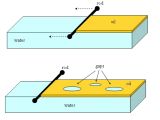You are being told that the world is made of atoms. But how can you yourself check that this is indeed true? I will tell you how to do a very simple experiment that shows the world is indeed discontinuous - that the apparently continuous, i.e. infinitely separable matter, is in fact made of lumps of matter. This experiment will not tell very much about atoms themselves (in fact it will tell you more about molecules) but will nevertheless prove that the world is not continuous.
It is funny that George Gamov has invented this experiment in the 20th century but in principle someone could have had the idea even in Ancient Greece. The fact that for most of human history almost all educated people thought the world is continuous and that in principle you could divide anything ad infinitum is thus a mere accident - the means to prove them wrong were there, just that nobody had the idea how to do it.
The idea is this: Take a small box and fill it with water. Then, drop a small amount of oil (with a dropping glass or with a syringe) over the sheet of water but confine it to one side of the box with a rod. Then, slowly move the rod and expand the surface of the oil sheet.
You will see that at a certain moment the oil sheet will become so thin that gaps will appear. This already should make you think. If the oil would be continuous wouldn't it get thinner and thinner ad infinitum without any gaps ever appearing? But gaps do appear.
But if the oil is made of lumps of matter (known as "molecules") instead of continuous matter, than at a certain point the sheet of oil reaches the situation that its thinness is 1 lump in size - and it cannot become any thinner, gaps have to appear.
Let's repeat the experiment. Drop the same amount of oil once again, and again slowly move the rod. What you will be able to observe is that the gaps in the sheet of oil always appear when the rod is at the same point. This means that the gap appearance phenomenon is objective - it doesn't happen because you, say, shake the box a little when you're moving the rod. The gap phenomenon always happens in the same way.
Thus, it really is true that the oil sheet is made of lumps. The interesting thing now is that you can even measure the size of these lumps. You known the volume of oil and you can measure the surface of the oil sheet when gaps are just starting to appear. Then, the height of the oil sheet at that moment is the volume divided by the surface. We can speculate that the oil lumps are somewhat round, and thus this height is more or less the diameter of one oil lump (of one oil molecule).
Finally there is one more thing that we can observe. We observed that the gaps always appear when the rod reaches the same position, but the location where each gap appears is different each time. We can't infer something precisely from this fact. It may be than small differences from experiment to experiment determine these differences in gaps locations. Or it may be that there is something intrinsically random about how the lumps behave inside the oil sheet. Other experiments show that the latter is true.
Thus, this seemingly continuous type of matter, liquid, is in fact made of lumps.

 14 DAY TRIAL //
14 DAY TRIAL // 
